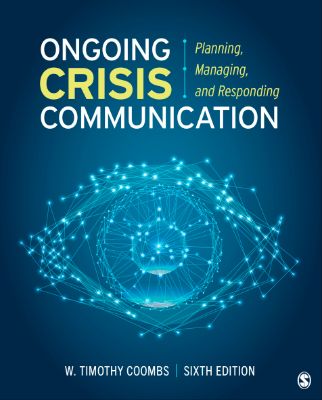
Námskeið
- Almannatengsl II
Lýsing:
Ongoing Crisis Communication: Planning, Managing, and Responding provides an integrated approach to crisis communication that spans the entire crisis management process and crosses various disciplines. A truly integrative and comprehensive text, this book explains how crisis management can prevent or reduce the threats of a crisis, providing guidelines for how best to act and react in an emergency situation.
Annað
- Höfundur: W. Timothy Coombs
- Útgáfa:6
- Útgáfudagur: 2021-12-20
- Hægt að prenta út 2 bls.
- Hægt að afrita 2 bls.
- Format:ePub
- ISBN 13: 9781071816622
- Print ISBN: 9781071816646
- ISBN 10: 1071816624
Efnisyfirlit
- Preface
- Acknowledgments
- 1 A Need for More Crisis Management Knowledge
- Crisis Management Defined
- Disaster Defined
- Public Health Crisis Defined
- Organizational Crisis Defined
- Crisis Management
- The Initial Crisis Management Framework
- Why a Life Cycle Approach to Crisis Management?
- Outline of the Three-Stage Approach
- Precrisis
- Crisis Event
- Postcrisis
- A More Advanced View: The Regenerative Model of Crisis
- Importance of Crisis Management
- Value of Social Evaluations
- Stakeholder Activism
- Digital Naturals
- Broader View of Crises
- Negligent Failure to Plan
- Employer Duty of Care
- Chapter Summary
- Discussion Questions
- Crisis Management Defined
- 2 Risk as the Foundation for Crisis Management and Crisis Communication
- Enterprise Risk Management
- Risk in the Organizational Context
- Stakeholders and Risk
- Issues Management
- Reputational Risk
- Chapter Summary
- Discussion Questions
- 3 The Crisis Mitigation Process: Building Crisis-Resistant and Resilient Organizations
- Thinking About Risk Mitigation
- Known and Unknown Risks
- AI and Risk Management
- Paracrisis: Unique Risk Mitigation
- Boyd’s OODA Loop: A Crisis Mitigation Process
- Application of the Boyd OODA Loop: Observe
- External
- Internal
- Running Example: Pampers
- Application of the Boyd OODA Loop: Orient
- Orient: Collect the Information
- Running Example: Pampers
- Orient: Analyze the Information
- Summary
- Running Example: Pampers
- Application of the Boyd OODA Loop: Decide and Act
- Decide: Make Choices
- Running Example: Pampers
- Act: Take Preventive Action
- Running Example: Pampers
- Chapter Summary
- Discussion Questions
- Thinking About Risk Mitigation
- 4 Crisis Preparing: Part I
- Diagnosing Crisis Threats: The Start of Preparing
- Risk as Foundation for Crisis Management and Communication
- Assessing Crisis Types
- Selecting a Crisis Management Team
- Functional Areas
- Interpersonal (Political) Skills
- Task Analysis
- Group Decision-Making
- Working as a Team
- Enacting the Crisis Communication Plan
- Listening
- Curiosity
- Implications for Crisis Management Team Selection
- Training a Crisis Management Team
- Applications for Training
- Improvisation’s Relationship to Crisis Management Team Training
- Resilience: Training Beyond the Crisis Team
- Resilience Training for Employees
- Resilience Training for the Community
- Special Considerations
- Selecting and Training a Spokesperson
- The Spokesperson’s Role
- Media-Specific Tasks of the Spokesperson
- Appearing Pleasant on Camera
- Answering Questions Effectively
- Presenting Crisis Information Clearly
- Handling Difficult Questions
- Spokespersons in a Digital World
- Chapter Summary
- Discussion Questions
- Diagnosing Crisis Threats: The Start of Preparing
- 5 Crisis Preparing: Part II
- Developing a Crisis Communication Plan
- Value
- Components
- Beyond the Crisis Communication Plan
- Crisis Appendix
- The CCP Alone Is Not Enough
- Other Related Plans
- Reviewing the Crisis Communication System
- Mass Notification System
- Crisis Control Center
- Social Intranet: Internal Digital Platforms
- Stakeholder Preparation
- Chapter Summary
- Discussion Questions
- Developing a Crisis Communication Plan
- 6 Recognizing Crises
- Selling the Crisis
- Crisis Framing: A Symbolic Response to Crises
- Crisis Dimensions
- Expertise of Top Management
- Persuasiveness of the Presentation
- Organizing the Persuasive Effort
- Resistance to Crises
- Crises and Information Needs
- Crises as Information Processing and Knowledge Management
- What You Need to Know
- Information Gathering
- Information Processing: The Known
- Information Processing Problems
- Serial Reproduction Errors
- The MUM Effect
- Message Overload
- Information Acquisition Bias
- Group Decision-Making Errors
- Summary
- Information-Processing Mechanisms
- Structural Elements
- Procedural Elements
- Training
- Chapter Summary
- Discussion Questions
- Selling the Crisis
- 7 Crisis Responding
- Tactical Considerations: Form of the Crisis Response
- Responding Quickly
- Speaking With One Voice: Consistency
- Transparency: The New Openness
- A Strategic Focus: Crisis Communication as Strategic Communication
- The Target Audiences for Crisis Response Strategies
- Objectives: What Crisis Communication Hopes to Accomplish
- Communication Channels and Platforms for Crisis Communication
- The Sources for Crisis Communication
- How It All Comes Together
- Crisis Response Strategies: Adjusting and Instructing Information
- Instructing Information: Physical Harm
- Adjusting Information: Psychological Well-Being
- Pairing Instructing and Adjusting Information
- Crisis Response Strategies: Reputation Management Strategies
- Message Design: From Strategy to Tactics
- Tone of Voice
- Emotion in Messages
- Storytelling
- Transparency
- Accommodation Variations
- Message Design Summary
- Organizing the Messages
- Message Design: From Strategy to Tactics
- Tactical Considerations: Form of the Crisis Response
- Contextual Factors: Evaluating Reputational Threats
- Evaluating Crisis Threats
- Severity
- Offensiveness
- Contingency Theory
- SCCT
- Takeaway
- Specialized Audiences and Multiple Voices
- Crisis Engagement
- Evaluating Crisis Threats
- Chapter Summary
- Discussion Questions
- Continuing the Crisis Performance
- Continuity of Actions
- Memorials and Shrines
- The Big Picture
- Crisis Communication Evaluation and Refinement
- Crisis Management Performance Evaluation
- Data Collection
- Organizing and Analyzing the Crisis Management Performance Data
- Impact Evaluation
- Specific Measures: Assessing Objectives
- General Measures
- Crisis Management Performance Evaluation
- Organizational Memory
- Organizational Learning
- Learning Beyond the Organization
- Knowledge Management: Connecting the Pieces
- Musings: Taking an Evidence-Based Approach Seriously
- Musings: Simplicity, Complexity, and Effectiveness
- Musings: Time and Crises
- Threads
UM RAFBÆKUR Á HEIMKAUP.IS
Bókahillan þín er þitt svæði og þar eru bækurnar þínar geymdar. Þú kemst í bókahilluna þína hvar og hvenær sem er í tölvu eða snjalltæki. Einfalt og þægilegt!Rafbók til eignar
Rafbók til eignar þarf að hlaða niður á þau tæki sem þú vilt nota innan eins árs frá því bókin er keypt.
Þú kemst í bækurnar hvar sem er
Þú getur nálgast allar raf(skóla)bækurnar þínar á einu augabragði, hvar og hvenær sem er í bókahillunni þinni. Engin taska, enginn kyndill og ekkert vesen (hvað þá yfirvigt).
Auðvelt að fletta og leita
Þú getur flakkað milli síðna og kafla eins og þér hentar best og farið beint í ákveðna kafla úr efnisyfirlitinu. Í leitinni finnur þú orð, kafla eða síður í einum smelli.
Glósur og yfirstrikanir
Þú getur auðkennt textabrot með mismunandi litum og skrifað glósur að vild í rafbókina. Þú getur jafnvel séð glósur og yfirstrikanir hjá bekkjarsystkinum og kennara ef þeir leyfa það. Allt á einum stað.
Hvað viltu sjá? / Þú ræður hvernig síðan lítur út
Þú lagar síðuna að þínum þörfum. Stækkaðu eða minnkaðu myndir og texta með multi-level zoom til að sjá síðuna eins og þér hentar best í þínu námi.
Fleiri góðir kostir
- Þú getur prentað síður úr bókinni (innan þeirra marka sem útgefandinn setur)
- Möguleiki á tengingu við annað stafrænt og gagnvirkt efni, svo sem myndbönd eða spurningar úr efninu
- Auðvelt að afrita og líma efni/texta fyrir t.d. heimaverkefni eða ritgerðir
- Styður tækni sem hjálpar nemendum með sjón- eða heyrnarskerðingu
- Gerð : 208
- Höfundur : 15357
- Útgáfuár : 2022
- Leyfi : 380


